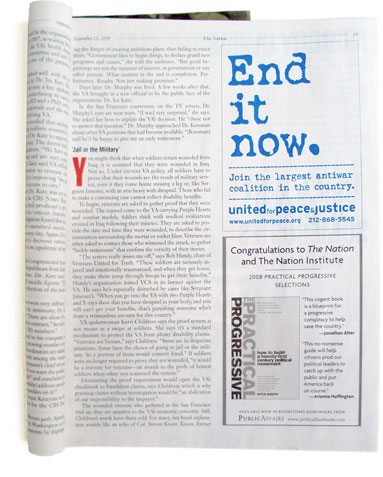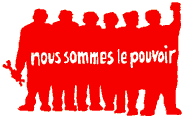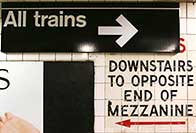Found 3599 matches from 1,400 records in about 0.1235 seconds for twitter or is or lazy.
An ad I designed for United for Peace & Justice ran in the September 15, 2008 issue of The Nation. The ad runs along side the cover story on the U.S. government’s shameful treatment of veterans.
It’s nicely bold and direct in print. It’s also the first time UfPJ ran with copy I came up with. In the design process I showed a couple of sketches using the text they’d provided, and a couple without.

Here are a couple of previous projects for UfPJ.
It’s among the most recognizable images in Holland. The poster below was drawn by Opland, the pseudonym of Rob Wout, one of Holland’s most popular political cartoonists in the second-half of the twentieth century. For 53 years, from age 19 until his death in 2001, Opland drew caricatures and political cartoons for De Volkskrant and De Groene Amsterdammer. In 1981, at a high point in his career, Opland contributed this cartoon to the anti-nuclear movement. The slogan reads ‘No new nuclear weapons in Europe.’ It became one of his most famous images in the peace movement outside the Netherlands, as well. The image is a nice mix of humor and outrage, clarity and simplicity, with a dash of familiarity. How could you say no to her?

The anti-nuclear movement in Holland had been active through the late-1970’s and in 1978 an unexpected coalition of Communists, leftists, and religious groups organized nation-wide protests and petitions that successfully pressured the center-right government to disallow U.S. neutron warheads in the Netherlands. However, a year later Prime Minister van Agt endorsed NATO plans to deploy additional U.S. nuclear warheads to Holland, though in deference to domestic pressure, postponed a final decision. Citizens were outraged and took to the streets, holding one of Amsterdam’s largest protests ever in November 1981. American pundit Walter Laqueur coined the term Hollanditis to describe the movement and its influence on other European countries, particularly West Germany. Around a quarter of the population of the Netherlands signed a petition against the deployment and the movement culminated in a record-breaking one million strong demonstration in The Hague in 1983. In May 1984, a nation-wide week of protest was held and 900,000 people participated in a 15-minute general strike.
Still, on November 1, 1985, after the Soviet Union failed to comply with a Dutch ultimatum and in a period of escalating cold war tensions, the Dutch parliament voted to allow 48 American missiles on Dutch soil, to deploy by 1988. In the end, the new warheads never arrived. In 1987 the Presidents Reagan and Gorbachev signed the Intermediate-Range Nuclear Forces Treaty to eliminate intermediate range missiles.

Anti-Nazism and the Ateliers Populaires: The Memory of Nazi Collaboration in the Posters of Mai ’68 is an excellent essay on the origins and context of the Ateliers Populaires, a collective poster workshop supporting the striking students and workers in France. Among the things I learned:
- There were several Ateliers Populaires in several cities in France. Paris alone had 6.
- The posters appeared in something of a vacuum, and were all the more shocking because of this. Political posters had not been seen on the streets in 20 years.
- The first posters were originally intended as fine art prints for sale to raise money for the striking workers, not as street art, and were originally printed by offset lithography, a more labor intensive process. These were taken out to the streets by popular demand where they inspired others to do the same.
- The style and simplicity of the designs was a function of both the medium and the conditions of production: the low-tech, improvised silkscreen apparatus and the incredible speed at which they were produced.
- The cheap newsprint paper they printed on were remnants donated by newspaper printers, who couldn't use the last bits of their paper rolls.
- Anyone could submit a design or slogan and designs were argued over collectively.
- Despite the progressive politics, the role of women in the studios was rather regressive.
- In some cases, the artists chose a more provocative poster idea over a more politically sensitive one. The posters comparing the French security apparatus to the Nazis and their tactics were particularly problematic and incendiary.
A US design student writes of her work for US AID getting out the vote in Rwanda in 2000:
“... Even something as simple as an image of a person displaying their voter registration card (as was depicted in the instructional voting poster) can have implications that an outsider would never anticipate. After election day, some people expressed strong feelings in response to this image. Apparently, the image of a person holding up their voter card recalled the ethnic identity cards used to divide Hutus and Tutsis and which were later used to target people during the genocide. People feared that the military police stationed at the voting booths might check their voter card for a stamp and look for ink on their thumb and if they were found to be without either, there could be grave consequences. When I initially learned of the reported ninety percent voter turn-out, I was thrilled. However, as I learned more about the politics of fear involved in these elections, I discovered that I might have unwittingly contributed to creating messages I did not intend. The visual is always political. It was a valuable lesson for me to learn. I just wish nobody else had to pay for it.”
 Screw the Flash game, since a pair was hurled at President George W. Bush the Model 271 shoe is flying off the shelf. “Baydan Ayakkabicilik San. & Tic. has received orders for 300,000 pairs of the shoes since the attack, more than four times the number his company sold each year since the model was introduced in 1999.... ‘Model 271’ is exported to markets including Iraq, Iran, Syria and Egypt. Customers in Iraq ordered 120,000 pairs this week and some Iraqis offered to set up distribution companies for the shoe, Baydan said.” More on The NY Times.
Screw the Flash game, since a pair was hurled at President George W. Bush the Model 271 shoe is flying off the shelf. “Baydan Ayakkabicilik San. & Tic. has received orders for 300,000 pairs of the shoes since the attack, more than four times the number his company sold each year since the model was introduced in 1999.... ‘Model 271’ is exported to markets including Iraq, Iran, Syria and Egypt. Customers in Iraq ordered 120,000 pairs this week and some Iraqis offered to set up distribution companies for the shoe, Baydan said.” More on The NY Times.
This has been blogged pretty heavily, but a friend hadn’t seen it so I’m posting it here. This is my favorite video short of this election cycle. It shows so much in just two minutes: war, Katrina, the economy, housing and infrastructure collapse... telegraphing familiar characters from their past comfort into the present crises, riding humor into pathos and back again into hope. For readers outside the US, the video is based on a short film that became a popular, widely aired TV ad some 8 years ago. More at wikipedia.

Previously from Shaw on this blog: typography and fascist architecture in Rome.
 I’m sure I’ve heard this term in passing, but today in a meeting with a foundation that’s historically focused on grassroots groups in New York City it really hit home how gentrification is pushing people to further strata of the urban donut. In the selection of its cover graphic, the organization chose to zoom out, widen the map and refer not to “New York City,” but the “New York City Area.”
I’m sure I’ve heard this term in passing, but today in a meeting with a foundation that’s historically focused on grassroots groups in New York City it really hit home how gentrification is pushing people to further strata of the urban donut. In the selection of its cover graphic, the organization chose to zoom out, widen the map and refer not to “New York City,” but the “New York City Area.”
The org, it seems, is increasingly working with people who can’t afford to actually live in the City, but who still work or organize there — people living in northeastern New Jersey, north of the Bronx or east of Queens.
It sounds a bit like “Bay Area” vs “San Francisco.” Something larger than the property lines of the five boroughs but smaller than the tri-state region or New York metropolitan area.
page 1 2 3 4 5 6 7 8 9 10 11 12 13 14 15 16 17 18 19 20 21 22 23 24 25 26 27 28 29 30 31 32 33 34 35 36 37 38 39 40 41 42 43 44 45 46 47 48 49 50 51 52 53 54 55 56 57 58 59 60 61 62 63 64 65 66 67 68 69 70 71 72 73 74 75 76 77 78 79 80 81 82 83 84 85 86 87 88 89 90 91 92 93 94 95 96 97 98 99 100 101 102 103 104 105 106 107 108 109 110 111 112 113 114 115 116 117 118 119 120 121 122 123 124 125 126 127 128 129 130 131 132 133 134 135 136 137 138 139 140 141 142 143 144 145 146 147 148 149 150 151 152 153 154 155 156 157 158 159 160 161 162 163 164 165 166 167 168 169 170 171 172 173 174 175 176 177 178 179 180 181 182 183 184 185 186 187 188 189 190 191 192 193 194 195 196 197 198 199 200 201 202 203 204 205 206 207 208 209 210 211 212 213 214 215 216 217 218 219 220 221 222 223 224 225 226 227 228 229 230 231 232 233 234 235 236 237 238 239 240 241 242 243 244 245 246 247 248 249 250 251 252 253 254 255 256 257 258 259 260 261 262 263 264 265 266 267 268 269 270 271 272 273 274 275 276 277 278 279 280 281 282 283 284 285 286 287 288 289 290 291 292 293 294 295 296 297 298 299 300 301 302 303 304 305 306 307 308 309 310 311 312 313 314 315 316 317 318 319 320 321 322 323 324 325 326 327 328 329 330 331 332 333 334 335 336 337 338 339 340 341 342 343 344 345 346 347 348 349 350 351 352 353 354 355 356 357 358 359 360
[ Back ]
[ Next ]

